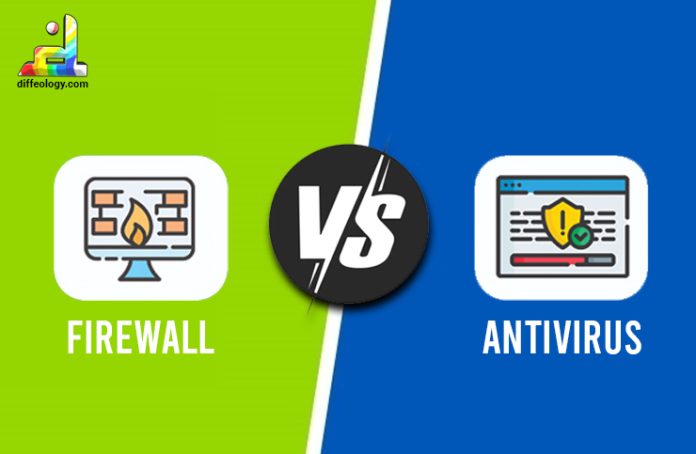Today, we’re diving into an exciting world of digital security. We’ll be exploring the Difference Between Firewall And Antivirus, those mighty guardians that keep our devices safe from cyber threats. Imagine these tools as your online superheroes, each with a unique power to shield your technology from harm. So, whether you’re a tech enthusiast or just someone who wants to understand how to stay secure in the digital realm, buckle up – we’re about to take a thrilling ride through the realm of firewalls and antivirus protection.
In this exploration, we’ll uncover the distinct functions of firewalls and Antivirus. We’ll dig into their features, strengths, and limitations. Get ready to unravel the mystery behind these cyber protectors and become a savvy guardian of your digital domain!
Main Difference Between Firewall And Antivirus
A firewall is hardware and/or software that prevents users from another network, such as the Internet, from gaining unauthorized access to a private network’s resources. Everyone who uses a computer on a network or the Internet should have a firewall in place. Antivirus software, on the other hand, may safeguard your PC by detecting and eliminating any viruses that may be lurking in your RAM, hard drive, or newly downloaded files.
Firewall Vs. Antivirus
What is Firewall?
It is a piece of software installed on a network to prevent malicious users from accessing the system. It simulates a physical wall between a secure local network and an insecure wide area network like the Internet. They prevent harmful or unauthorized data from entering or leaving a network by monitoring and restricting incoming and outgoing network traffic.
To function, they inspect data packets in transit across networks. To decide whether or not to let a packet through, they apply a set of rules that have already been established.
Read Also: Difference Between CMOS and BIOS
A data packet is allowed via It if and only if it satisfies the rules that have been established. It checks each packet against a set of rules and discards those that don’t match, letting in only trusted and approved data.
It is a security measure that prevents hazardous or undesirable information from entering a network. To do this, it thoroughly inspects incoming data packets against a predetermined set of criteria before deciding whether to grant or deny access. With the world’s computers becoming even more linked, this vital security technology is more important than ever.
Features
- Traffic Control: It manages incoming and outgoing data flow.
- Access Control: It regulates who can enter or leave the network.
- Packet Filtering: It examines data packets and allows/blocks based on rules.
- Stateful Inspection: It tracks active connections to make filtering decisions.
- Intrusion Detection: It identifies unusual or harmful activity.
- Proxying: It acts as an intermediary between users and the web.
- Network Address Translation (NAT): It hides internal IP addresses.
- Logging: It records events for analysis and monitoring.
- Application Layer Filtering: It inspects data at the application level.
- Virtual Private Network (VPN) Support: It enhances secure remote access.
Pros:
- Security Enhancement: They offer a strong defense against unauthorized access and cyber threats.
- Traffic Regulation: They control data flow, allowing only valid and safe information to pass through.
- Application Filtering: They can limit or allow specific applications based on defined rules.
- Network Segmentation: They help isolate critical systems, reducing potential damage in case of breaches.
- Logging and Monitoring: They provide valuable insights into network activity for analysis.
- Policy Enforcement: They enforce security policies, ensuring compliance with organizational standards.
- Protection from Malware: They can prevent malware from entering the network.
- Remote Access Security: They safeguard remote connections through Virtual Private Networks (VPNs).
- Bandwidth Optimization: They can prioritize traffic, optimizing network performance.
Cons:
- False Positives/Negatives: They may block legitimate traffic or allow malicious content.
- Complex Configuration: Setting up complex rules requires technical expertise and can be time-consuming.
- Limited Encrypted Traffic Inspection: Encrypted data can bypass traditional firewalls, creating potential security gaps.
- Performance Impact: Intensive traffic scanning can slow down network speeds.
- Single Point of Failure: If it fails, the entire network’s security is compromised.
- Intrusion Prevention Limitation: Advanced attacks can evade basic firewall intrusion detection.
- Maintenance Overhead: Regular updates and rule adjustments are necessary to keep it effective.
- Costs: They entail initial expenses for hardware, software, and ongoing maintenance.
- User Privacy Concerns: Deep packet inspection by them may raise privacy issues.
- Resource Intensive: Managing them requires dedicated resources and expertise.
What is Antivirus?
Virus protection software is a sort of software that helps keep your computer or mobile device safe from invading software. Emails, file downloads, and malicious websites are all potential entry points for these malicious programs, which function similarly to digital pathogens.
It protects your computer like a digital shield, scanning for and eliminating viruses at all times. It analyzes data and code to see whether it contains any viruses based on established signatures. Having this kind of protection for your digital space is like having a personal security guard.
Read Also: Difference Between Java and JavaScript
It’s like washing your hands to avoid getting sick – it’s a preventive measure that can save you a lot of trouble in the long run. So, having a good Antivirus installed and regularly updated is a smart choice to help keep your digital life worry-free.
Features
- Real-Time Scanning: The Antivirus constantly watches your files and programs, checking for any signs of viruses as you use your device.
- Scheduled Scans: You can set up the Antivirus to scan your device at specific times, ensuring regular checks for viruses even when you’re not using it.
- Virus Removal: If a virus is detected, the Antivirus can remove or isolate it, preventing further harm.
- Quarantine: Suspicious files are placed in quarantine, a safe area where they can’t harm your device while you decide what to do with them.
- Automatic Updates: The Antivirus regularly updates itself to stay up-to-date with the latest virus definitions and security measures.
- Firewall: Some antivirus programs include a firewall that acts as a barrier between your device and potential threats from the Internet.
- Web Protection: This feature checks websites for malicious content and warns you if a site seems unsafe to visit.
- Email Scanning: Antivirus scans your incoming emails and attachments to catch any viruses that may be hiding there.
- Anti-Phishing: It can also help you avoid phishing scams by detecting fraudulent websites that try to steal your personal information.
- Parental Controls: Some antivirus programs offer tools to help parents manage and monitor their children’s online activities.
Pros:
- Virus Protection: Antivirus is highly effective in detecting and removing viruses, keeping your device safe from malicious programs.
- Real-Time Monitoring: It offers continuous monitoring, instantly catching and neutralizing threats as they emerge.
- Peace of Mind: Using Antivirus can provide a sense of security, knowing that your device is being actively protected.
- Regular Updates: Antivirus programs regularly update their databases to tackle new and evolving threats, enhancing your device’s defense.
- Additional Features: Many antivirus packages include extras like firewalls, web protection, and parental controls, enhancing overall online safety.
Cons:
- Resource Consumption: Antivirus can use a portion of your device’s resources, potentially slowing down its performance.
- False Positives: Sometimes, legitimate files or programs are flagged as threats, leading to disruptions in normal usage.
- Costs: While some basic versions are free, comprehensive antivirus suites with advanced features often come with subscription fees.
- Limited Protection: Antivirus may not defend against all types of online threats, such as zero-day exploits or sophisticated attacks.
- User Dependency: Effective antivirus use requires regular updates and cautious online behavior, relying on user awareness.
Difference Between Firewall and Antivirus in Detail
Functionality
A firewall acts as a virtual barrier between your computer or network and potential threats from the Internet. It keeps an eye on both incoming and outgoing data based on the rules you establish. It prevents unauthorized access by allowing only legitimate connections and blocking suspicious or malicious ones. Also, it works like a gatekeeper. It means that it can manage the data going to and from your system.
Antivirus, on the other hand, focuses on detecting and removing malicious software that has already entered your system. It scans files, programs, and other data for patterns that match known malware signatures. When a match is found, the Antivirus takes action to isolate, quarantine, or delete the infected files. Its main goal is to spot and remove any current threats to your computer.
Types of Threats
Firewalls mainly protect against outside threats, like hackers or cybercriminals trying to access without permission. They’re like the security guards stationed at the entrance of your network, ensuring that only authorized traffic gets through and keeping potential intruders out.
Antivirus primarily targets viruses, worms, Trojans, and different types of malware. They can sneak into your system. It’s like a detective that scans your computer’s files and programs, searching for any signs of malicious activity and removing them to prevent further damage.
Scope of Protection
Firewalls provide broader protection at the network level. Routers and other network devices may be configured with them to provide network-wide traffic filtering. This helps secure multiple devices simultaneously and is particularly useful for businesses or households with multiple computers and devices.
Antivirus offers targeted protection at the device level. It scans the files and programs on the device or computer it was installed on to make sure nothing malicious is lurking around. It’s suitable for individual devices and is an important layer of defense alongside a firewall.
Real-time Monitoring
Firewalls continuously monitor network traffic in real time, analyzing data packets to determine whether they should be allowed or blocked based on established rules. Taking this preventive step reduces the chance that harmful actors may gain entry into your system.
Antivirus offers continuous security by scanning all downloaded, opened, and executed items. It monitors your device constantly for any suspicious behavior and then removes any malicious software it finds.
Prevention vs. Removal
Firewalls emphasize prevention. They aim to stop threats from entering your network in the first place. By enforcing access controls and filtering traffic, firewalls significantly reduce the chances of unauthorized access or cyberattacks.
Antivirus focuses on removal. It deals with threats that have already infiltrated your system. After identifying harmful data or software, it takes steps to remove it and stop any further damage.
Proactive vs. Reactive
Firewalls proactively guard against potential threats by acting as a barrier between your network and the outside world. They anticipate and block suspicious activities before they can cause harm.
Antivirus reacts to existing threats by identifying and neutralizing them. It provides a reactive defense mechanism that kicks in when malware is detected.
Resource Usage
Firewalls generally consume fewer system resources as they focus on monitoring traffic and enforcing access controls. They’re designed to operate in the background without significantly impacting the performance of your device.
Antivirus may consume more system resources, especially during active scans or real-time monitoring. Scanning for malware requires processing power and memory, which can lead to temporary performance slowdowns.
Interaction with Users
Firewalls often operate with minimal user interaction. They are configured with predefined rules that determine how traffic is handled. Users may need to adjust settings occasionally, but daily operation usually requires little intervention.
Antivirus may require more user interaction. Users need to initiate scans, review scan results, and make decisions about potential threats. Regular updates are also crucial to ensure the Antivirus has the latest malware definitions.
Comprehensive Protection
In safeguarding networks, a firewall plays a vital role. It serves as the first line of defense, helping to prevent unauthorized access and ensuring that only legitimate traffic flows in and out.
When used in conjunction with a firewall, Antivirus protects against viruses that may otherwise penetrate the system. It’s crucial to discover and remove any viruses or harmful software as they may already exist on your computer.
Comparison Table “Firewall Vs. Antivirus”
| Aspect | Firewall | Antivirus |
|---|---|---|
| Functionality | Acts as a barrier between computer/network and internet threats. Monitors data based on set rules. Manages incoming/outgoing data. | Detects and removes malicious software from the system. Scans files for known malware patterns. Focuses on existing threats. |
| Types of Threats | Guards against unauthorized access and cyberattacks. Filters network traffic. | Targets viruses, worms, Trojans, and malware already in the system. Removes active threats. |
| Scope of Protection | Provides network-wide protection, useful for multiple devices. | Offers protection on a single device by scanning files and programs. |
| Real-time Monitoring | Analyzes data packets in real time. Blocks or allows based on rules. | Monitors downloaded, opened, and executed items for suspicious behavior. |
| Prevention vs. Removal | Prevents threats from entering the network. Enforces access controls. | Removes threats that have infiltrated the system. Stops further damage. |
| Proactive vs. Reactive | Proactively blocks potential threats. | Reactively neutralizes existing threats. |
| Resource Usage | Consumes fewer resources work in the background. | May use more resources during scans, leading to temporary slowdowns. |
| Interaction with Users | Requires minimal user interaction. Operates with predefined rules. | Requires user-initiated scans, review of results, and decisions about threats. |
| Comprehensive Protection | The first line of defense for networks prevents unauthorized access. | Works alongside firewall to detect and remove viruses already present. |
Key Points Difference Between Firewall and Antivirus
- Function: Firewall Monitors and controls incoming and outgoing network traffic based on predetermined security rules. Antivirus Scans and detects malicious software (viruses, malware) present in files, programs, and devices.
- Focus: Firewall Emphasizes network traffic filtering and access control to prevent unauthorized access. Antivirus Concentrates on identifying and removing specific types of malicious software.
- Scope: Firewall Manages network-level traffic, applicable to all devices connected to the network. Antivirus Operates on individual devices, targeting specific files and software.
- Protection Type: Firewall Guards against unauthorized network access, hacking attempts, and data breaches. Antivirus Defends against viruses, worms, Trojans, and other malicious software.
- Monitoring: Firewall Constantly monitors network data packets, permitting or blocking based on defined rules. Antivirus Regularly scans files, software, and devices to identify and eliminate malware.
- Interactivity: Firewall Reacts in real-time to network traffic, making immediate decisions on data packet passage. Antivirus Often requires manual scans or schedules for checking devices and files.
- Preventive vs. Reactive: Firewall Primarily prevents unauthorized access and potential breaches before they occur. Antivirus Reacts to existing malware, removing threats after detection.
- Connection to Internet: Firewall Sits between a private network and the Internet, controlling traffic entering and leaving. Antivirus Operates within an individual device, safeguarding it from malware threats.
- Complementary Use: Firewall Often used alongside Antivirus to provide comprehensive security. Antivirus is Often used alongside firewalls to protect against network-based attacks.
- Real-time Impact: Firewall Can affect network speed and connectivity due to its continuous monitoring. Antivirus Can impact device performance during scans, especially full-system scans.
- Placement: Firewall Positioned at the network perimeter, typically on routers or servers. Antivirus Installed on individual devices such as computers and smartphones.
- Response to Threats: Firewall Blocks suspicious network traffic based on predefined rules and settings. Antivirus Removes or quarantines detected malicious software to prevent further harm.
FAQs: Firewall Vs. Antivirus
Conclusion
In the ever-evolving landscape of digital security, understanding the dynamic interplay between firewalls and Antivirus is akin to mastering the art of self-defense in the online realm. These two guardians, with their distinct yet complementary roles, stand as the stalwart protectors of our digital lives. As we bid farewell to this exploration, let’s recap the journey and underscore the significance of these cybersecurity stalwarts.
Firewalls, like vigilant sentinels, stand as the first line of defense, safeguarding our networks against external threats. With their keen eyes and rule-based judgments, they fortify the walls of our digital castles, granting passage only to the trustworthy and repelling the malevolent.
Antivirus, on the other hand, embodies the spirit of vigilance within our devices. It tirelessly scans, detects, and eradicates the lurking digital pathogens that could wreak havoc within our systems. Just as a skilled detective investigates and eliminates potential threats, Antivirus patrols our digital playgrounds, ever watchful for the telltale signs of malware and viruses. In a world where new threats emerge daily, having this digital guardian is akin to having a steadfast companion that shields us from harm.
So, as you navigate the boundless horizons of the Internet, remember the lessons learned here – that in this interconnected world, vigilance and preparedness are our most potent weapons, and firewalls and Antivirus are our unwavering allies. With knowing the Difference Between Firewall And Antivirus, go forth with confidence, for you are now armed with the power to safeguard your digital kingdom.
References & External Links
- Why Do I Need Firewall.
- Antivirus Software Functions, Working ,Examples and Advantages



